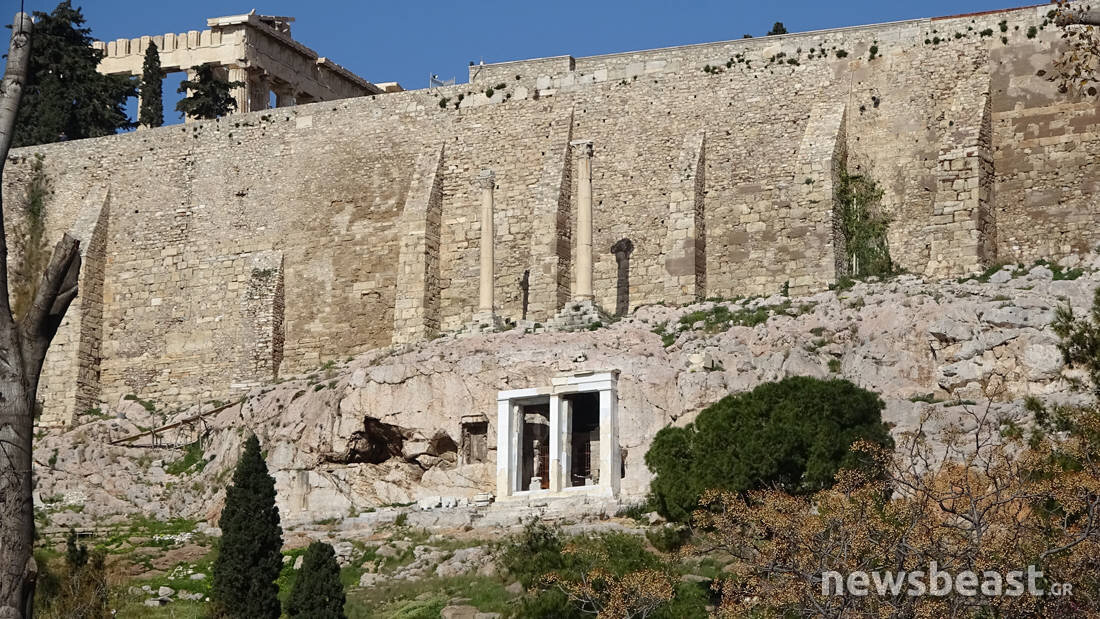The Acropolis is not only one of the most famous archeological sites in the world. It is also a place that knows how to hide its secrets well.
For many decades, passers-by from around the Acropolis have wondered what this cave on the southern slope of the Sacred Rock is. The construction site of the last few years has revealed that another restoration program is being carried out there. Walkers of Dionysios Areopagitis street wanted to know more about this monument that catches their eye when they look at the Theater of Dionysus.
Most people are surprised when they learn the double history of this particular monument that adorned the rock of the Acropolis for more than 23 centuries.
Two signs with information material about Thrasyllio and Panagia Spiliotissa have been placed in an appropriate place under the monument by the Ephorate of Antiquities of Athens
The sponsored Thrasyllos monument rises imposingly above the Dionysios Areopagitis and Makrygiannis Street and impresses the people as it seems huge when you look at it from the Dionysos Theater.
It was created around 320 BC by Thrasyllos, an organiser of the Great Dionysians, and was shaped like a temple. The monument collapsed after shelling in 1827, during the siege of the Acropolis by the Turks. Today, the iron railings tell in their own way that something valuable is hidden inside.
The figure of Thrasyllio in the middle, around the 18th century, by the British artists James Stuart and Nicholas Revett
The older ones know Panagia Spiliotissa, which was created during the Ottoman rule. The ancient and Christian monuments coexist in front and behind the cave.
The north wall of Panagia Spiliotissa after the restoration of the arch opening and the preservation of the fresco decoration
"The fresco decoration of Panagia Spiliotissa comprises the best preserved examples of post-Byzantine hagiography in the area of the Acropolis and its slopes", says Dr. Konstantinos Boletis, Architect-Restorer of the Ephorate of Antiquities of the City of Athens.
After being installed in the hollow, the sponsorship monument was kept almost unchanged until 1827, with some changes, such as blocking its two openings with walls. And it was always a popular motif in the historical iconography of the monuments of Athens of the 18th and early 19th centuries.
Thrasyllio in 2002, in its state of preservation before the start of the restoration program
In a central position above the monument, most works of historical iconography feature a marble statue of Dionysus, which, according to prevailing scholarly views, was erected in Roman times. This statue, Mr. Boletis explains, was removed in 1802 by order of Lord Elgin and can be seen today in the British Museum. As for the Christian church behind the facade of the ancient monument, there is much to suggest that it can be dated to the period of Ottoman rule. It has a three-part internal structure that follows the shape given to the cave since ancient times.
The Hierarch, which decorates the inside of the south wall of Panagia Spiliotissa after it was repaired by the Conservation Department of the Ephorate of Antiquities of Athens. The south wall, like the north wall, was fixed and mostly repointed by the marble craftsmen of the Department of Archeological Works and Studies of the Ephorate of Antiquities of Athens
They are two walls, in which important parts of their frescoes are preserved, contributing to the rudimentary internal organization of the church.
According to Mr. Boletis, Athenian mothers came to this church during the Turkish occupation to pray for the health of their sick children. According to another tradition, the custom of humiliation of women who cheated on their husbands, took place in the area of the cave.
The restoration of the monument
The program of restoration of the funded monument and restoration of the walls of Panagia Spiliotissa inside the cave was completed in early 2017. At the same time, all site equipment occupying areas of the monument was removed. After all elements of the site were dismantled and demolished, a systematic cleaning was carried out in the rocky part of the epitheatre (in an area of about 200 square meters) for the restoration of the space after the restoration program. Thrasyllio is a highly visible building and now offers a clear perception of a great sponsored monument in a transitional period of the ancient theater.
The monument of Thrasyllus after the completion of the restoration in January 2017
Source: newsbeast

















